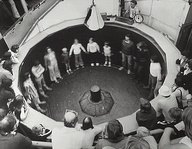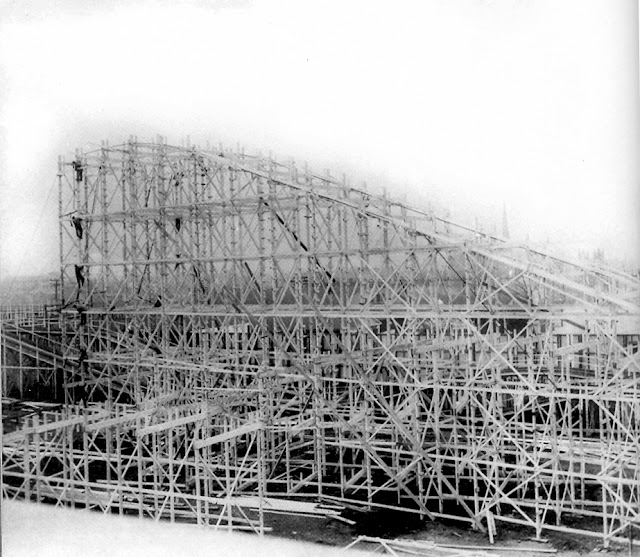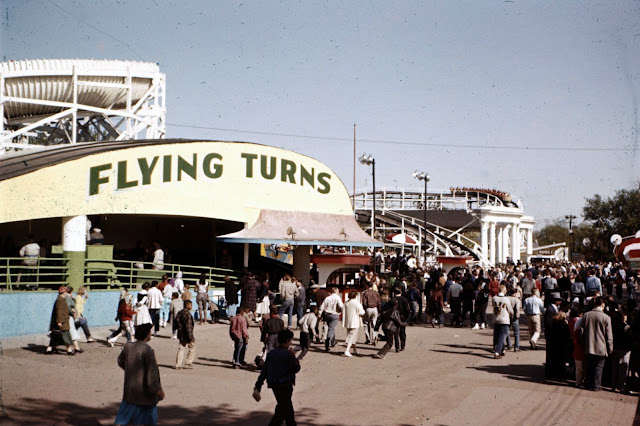Riverview Park was an amusement park in Chicago, Illinois which operated from 1904 to 1967.
It was located on 74 acres in an area bound on the south and east by Belmont and Western Avenues, respectively, on the north by Lane Technical High School and on the west by the north branch of the Chicago River.

Upon returning from Europe, George told stories of the parks he had seen, which boasted fantastic Ferris Wheels, Carousels, and more. He argued that these rides would attract people from all over, and with some monetary help from a lawyer named William Johnson and a banker, Joseph McQuade, his vision quickly became reality.
After that point, the park became known as "Riverview Sharpshooters' Park" and was home to three rides.
Unlike other parks, admission was close to free, and you paid separately for each ride. This approach appealed to the working class of Chicago and kept the park doing well for quite some time.
In 1906 the park saw a noteworthy increase in space, adding 50 acres and about 500,000 dollars worth of rides. Riverview was growing from a humble family-owned park to the kind of place kids swooned over.
In 1907 a new front gate was erected, followed by the addition of the Velvet Coaster, the Pikes Peak Scenic Railway, a racetrack, and a whole new section of the park called Fairyland.
In 1909 once again, the park's name changed to "Riverview Exposition Park" and became a household name. The addition of new rides continued ever strong, introducing The Tickler, Expo whirl, and Witching Waves in 1910 and the Metrodome in 1911. In 1913 there was yet another name change – and the final one – where the name was simplified to Riverview Park.
During the time of prohibition in the 1920s, Riverview was known as a speak-easy, as you could still find beer and liquor. Throughout the course of the decade, they continued adding more rides, including the most popular "The Bobs," with a nearly 90-foot drop.
At the end of the 1967 season, Riverview Park advertised its opening date for 1968. Shortly after the end of the season, the park announced on October 3, 1967, that it would not reopen. There was much speculation about why. The park had been profitable until it closed. It was rumored that escalating racial tensions and de facto segregation in Chicago in the 1960s made the owners uncomfortable and less willing to keep the park open.
Amusement Park Name History:
● Schützen (also: Schüetzen) Park aka Sharpshooters' Park, Chicago, IL. (1879-1903) [Schützenverein (German: Shooting Club)]
● Riverview Sharpshooters' Park, Chicago, IL. (1904-1908)
● Riverview Exposition Park, Chicago, IL. (1909-1912)
● Riverview Park, Chicago, IL. (1913-1967)
Riverview Roller Coaster History:
NOTE: Riverview was known to rename a roller coaster after an accident occurred.
">" = "Renamed to"
Aerial Coaster (1908-1910)
Big Dipper (1920) > Zepher (1936) > Comet (1940-1967)
Blue Streak [The Original] (1911-1923)
Bobs (1924-1967)
Cannon Ball (1919-1925)
Derby Racer (1909-1932)
Fireball (1959-1967)
Flying Turns (1935-1967) [purchased after the 1933-34 World's Fair closed]
Gee Wiz (1912) > Greyhound (1913-1965) > Jetstream (1965-1967)
Jack Rabbit (1915-1919)
Kiddie Bobs (1926-1934)
Pikes Peak Scenic Railway (1907-1911)
Pippin (1921) > Silver Streak (1938) > Silver Flash (19??) {Shortened to} Flash (1961-1967)
Royal Gorge Scenic Railway (1908-1920)
Skyrocket (1923) > Blue Streak (1936-1958)
Tickler (1906-????)
Top (1907-1916)
Velvet Coaster (1909-1919)
White Flyer (1904-1920s)
Wild Mouse (1958-1967)
The Flying Cars was a German-made ride built for Chicago's great Riverview Park in 1954. Riders were strapped into a small car inside a large rotating barrel. The barrel had a track inside for the cars to ride freewheeling. A rail and floating clamp system held the cars onto the drum. As the drum spins, the 1 person's car follows the track and eventually begins to go upside down.
The drum steadily increases its speed, and the cars let it roll beneath their wheels as they follow the track. The cars' brakes are then applied to cause them to quickly accelerate up to the speed of the drum's surface, which is around 30 mph, causing the cars to go 360°. The operator of Flying Cars would spin the drum for two minutes and then release the brakes, causing the cars to come to a complete stop while the drum also slows to a halt. It sounds like fun! Unfortunately, someone failed to fasten their safety belt properly and was killed after falling out. That was the end of the Flying Cars.






 |
| One of Three Original Rides. |
In 1906 the park saw a noteworthy increase in space, adding 50 acres and about 500,000 dollars worth of rides. Riverview was growing from a humble family-owned park to the kind of place kids swooned over.
In 1907 a new front gate was erected, followed by the addition of the Velvet Coaster, the Pikes Peak Scenic Railway, a racetrack, and a whole new section of the park called Fairyland.
 |
| Velvet Coaster. |
In 1908 they introduced two new attractions, which stunned and amazed park-goers. The first was the Battle of the Monitor and Merrimac, a recreation of the Civil War naval battle. The second was a 70-foot carousel, admired greatly for being hand-carved and painted by a group of Swiss and Italian craftsmen.
 |
| The Merry-Go-Round, installed in 1904, was a concession at Riverview Sharpshooters' Park owned by the Eastern group. It was second in popularity to the Figure 8 roller coaster. The "Morris Merry-Go-Round" was described by the owner as having "very handsome figures in an octagon pavilion 100 feet across and 45 feet high." The cost of a ride was 5¢. In the foreground is a glass etching souvenir booth. The larger E. Joy-Morris "Fairyland Carousel" did not arrive until 1908. |
 |
| Riverview Sharpshooters' Park Merry-Go-Round. |
Winter saw the addition of a roller rink and ballroom often filled with jubilant jazz and courting couples. At this point, the park had grown to 102 acres and continued adding eateries, games, shows, and more.
In 1909 once again, the park's name changed to "Riverview Exposition Park" and became a household name. The addition of new rides continued ever strong, introducing The Tickler, Expo whirl, and Witching Waves in 1910 and the Metrodome in 1911. In 1913 there was yet another name change – and the final one – where the name was simplified to Riverview Park.
 |
| The Big Dipper, in the 1920s |
 |
| The Big Dipper, in the 1920s |
That wasn't the only thing breaking records. George Schmidt also invented the famous foot-long hot dog around this time to be filling and inexpensive when things became hard during the depression. During this time period, Riverview adopted the motto "Laugh Your Troubles Away at Riverview!"
Riverview saw prosperity throughout the 1950s, becoming a favorite to the returning servicemen of WWII. The late 50s also brought a new slogan, "Riverview Park - Just for Fun."
 |
| Riverview Park hosted a live radio show with Buddy Black called "Riverview Funtime" that aired on WGN-AM 720 in the 1950s. |
The early 1960s were good years for the baby boomer generation.
 |
| The intersection of Belmont, Western, and Claybourn Avenues, looking west on Belmont. Note the Riverview sign. 1960 |
In truth, however, Riverview Park likely closed for economic reasons. While it was profitable, the $6.5 million sales price was too good to pass up, and within a few months, Riverview Park was no more.
What became of Riverview’s rides and attractions?
Unfortunately, most were smashed into oblivion shortly after Riverview Park in Chicago closed its doors for the final time. Although the park’s owners held an auction just after closing, none of the 50 bidders wanted attractions such as the Pair-O-Chute Jump, the Space Ride, the flash High Ride, or even the world-famous Bobs roller coaster.
 |
| 1967 Riverview Park Ride Auction Advertisement. |
In its day, the Bobs was billed as the world’s faster roller coaster, attaining a top speed of more than 60 miles per hour. According to a 1953 article in the Chicago American, the Bobs was the most thrilling ride in America.
The Chicago Sun-Times recalled the Bobs in a feature article not long ago: “It was a mind-numbing, body-bruising, 120-second dash through twisted metal and rickety white wood; when it was over, you’d be battered and breathless.”
Nonetheless, it was unwanted at the auction, and shortly thereafter, it was demolished and sold for scrap, along with Riverview’s five other roller coasters — the Fireball, the Wild Mouse, the Silver Streak, the Comet, and the Greyhound. Shoot-the-Chutes was also demolished, as was the giant genie’s head that grimaced above the entrance to Aladdin’s Castle.
Many of the smaller rides, like the Ferris wheel and miniature train, were sold to carnivals in different parts of the country. A Chicagoan bought four children’s rides — The Whip, Kiddy Merry-Go-Round, Kiddy Bug, and Kiddy Boat — for $2,800.
The only Riverview Park ride that survives today is the Carousel. Six Flags over Georgia restored it just west of Atlanta and listed it on the National Register of Historic Places in 1995.
Amusement Park Name History:
● Schützen (also: Schüetzen) Park aka Sharpshooters' Park, Chicago, IL. (1879-1903) [Schützenverein (German: Shooting Club)]
● Riverview Sharpshooters' Park, Chicago, IL. (1904-1908)
● Riverview Exposition Park, Chicago, IL. (1909-1912)
● Riverview Park, Chicago, IL. (1913-1967)
Riverview Roller Coaster History:
NOTE: Riverview was known to rename a roller coaster after an accident occurred.
">" = "Renamed to"
Aerial Coaster (1908-1910)
Big Dipper (1920) > Zepher (1936) > Comet (1940-1967)
Blue Streak [The Original] (1911-1923)
Bobs (1924-1967)
Cannon Ball (1919-1925)
Derby Racer (1909-1932)
Fireball (1959-1967)
Flying Turns (1935-1967) [purchased after the 1933-34 World's Fair closed]
Gee Wiz (1912) > Greyhound (1913-1965) > Jetstream (1965-1967)
Jack Rabbit (1915-1919)
Kiddie Bobs (1926-1934)
Pikes Peak Scenic Railway (1907-1911)
Pippin (1921) > Silver Streak (1938) > Silver Flash (19??) {Shortened to} Flash (1961-1967)
Royal Gorge Scenic Railway (1908-1920)
Skyrocket (1923) > Blue Streak (1936-1958)
Tickler (1906-????)
Top (1907-1916)
Velvet Coaster (1909-1919)
White Flyer (1904-1920s)
Wild Mouse (1958-1967)
VIDEOS
Flying Cars 1954
The Flying Cars was a German-made ride built for Chicago's great Riverview Park in 1954. Riders were strapped into a small car inside a large rotating barrel. The barrel had a track inside for the cars to ride freewheeling. A rail and floating clamp system held the cars onto the drum. As the drum spins, the 1 person's car follows the track and eventually begins to go upside down.
The drum steadily increases its speed, and the cars let it roll beneath their wheels as they follow the track. The cars' brakes are then applied to cause them to quickly accelerate up to the speed of the drum's surface, which is around 30 mph, causing the cars to go 360°. The operator of Flying Cars would spin the drum for two minutes and then release the brakes, causing the cars to come to a complete stop while the drum also slows to a halt. It sounds like fun! Unfortunately, someone failed to fasten their safety belt properly and was killed after falling out. That was the end of the Flying Cars.
Riverview Remembered by WGN
The Bobs Roller Coaster at Riverview
Riverview Amusement Park (circa 1952)
Compiled by Dr. Neil Gale, Ph.D.
CLICK ON ANY PHOTO TO VIEW ALL PICTURES IN FULL-SIZE IN AN ALBUM.
 |
| On the left: The tower ride was called "Expo-Whirl," which was installed in 1909 as a large swing ride. |
 |
| The "Expo-Whirl," Cars of the large tower swing ride. |

 |
| Deirdre Capone personally sent me this photograph of herself at Riverview in 1956. She is Al Capone's Grand Neice. The twin Ferris wheels, the Dodgem station, and the Flash roller coaster tracks are in the background. Deirdre personally told me how much she loved going to Riverview. |
 |
| ARTICLE: Removal of the "African Dip" Dunk Tank Game from Riverview Park in Chicago, Illinois. |

 |
| In the Foreground is the Grebe & Co. Inc. Shipyard. |

 |
| Riverview Park Clowns - Circa 1925 |
 |
| Shoot-the-Chutes. |

 |
| In the Foreground is the Grebe & Co. Inc. Shipyard. |
 |
| On the left is the Henry C. Grebe & Co. Inc. Shipyard on the Chicago River at Belmont Avenue. They built U.S. Navy Ships and pleasure cruisers. |

 |
| In the Foreground is the Grebe & Co. Inc. Shipyard. |
 |
| Riverview and Bally MFG Co. at 2640 W Belmont Ave, Chicago in the foreground. |
 |
| Photo by Walter Rieger |

 |
| Photo by Walter Rieger |
 |
| Photo by Walter Rieger |
 |
| Advertisement for Riverview Amusement Park, c.1930s |
Visit our Souvenir Shop on your way out.























































































































































































































